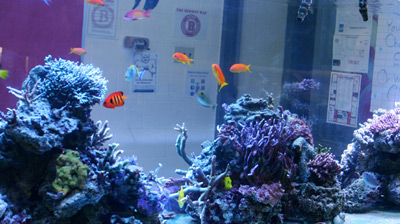In the first two parts of this series, we talked about how ozone can function as a powerful tool in keeping your reef aquarium water very clear, how it can boost your skimmer’s ability to remove waste from the water column by breaking down the larger molecules, and how using ozone can be as simple as blowing the gas into your skimmer or injecting it into a dedicated reactor and carbon media reactor. This final installment will focus on how to keep yourself and your aquarium inhabitants safe while using ozone.
Regardless of how you choose to administer your ozone, safety has to be your number one concern. Too much ozone in the tank will harm—or even kill—your invertebrates and fish. Too much ozone released into the room air can irritate a healthy adult’s lungs and is even more dangerous to anyone with lung-health issues.
Keeping your livestock safe

To keep their aquarium inhabitants safe, most keepers use an Oxidation/Reduction Potential (ORP) meter coupled with a controller that will switch the generator off when the ORP reaches a certain level. 300 mV is commonly considered to be a safe yet effective ORP level for the home aquarium. A controller uses the meter reading to shut the generator off when the water reaches the 300mV level or whatever level you may opt to use. Experts warn against ORP levels beyond 450 mV, as that level has been shown to cause major damage to aquarium systems.
Be sure to place your meter probe where the water is flowing freely, such as the main section of your sump. Don’t forget the little extras. Ozone breaks normal tubing down fairly quickly. Be sure to use ozone-safe silicone tubing and check valves. The check valves will keep water from flowing up the air lines and into the electrical devices in the event of a power outage.
Keeping the keeper safe
As much as we love our fishy friends, our highest priority must be human safety. The use of the monitor will greatly reduce the chances of overproduction of ozone, which can lead to excess ozone escaping into the fish room. As stated earlier, ozone is a lung irritant, even at a low level. A well-ventilated fish room is important, as is using a carbon air filter on the skimmer or reactor body to absorb any gas that does not break down in the reaction with your sea water.
Final thoughts on ozone use
Ozone use is not appropriate for every aquarium. Small tanks (under 75 gallons) are likely better served with just plain old “elbow grease” and water changes to keep the water sparklingly clear. On larger systems, such as the 1,000-gallon system at Bellevue High School (Bellevue, Ohio), water changes remain equally important but are not enough to keep the system crystal clear. The Bellevue system (like many other reef systems) uses macroalgae and mangrove trees as nutrient exporters. The result is a mild staining of the water, which is eradicated quite effectively by the ozone.
When used correctly, ozone is a great tool for the home aquarist. The safety of the keeper and fish must be taken into serious consideration. The use of a controller unit and keeping your fish room well ventilated will go a long way toward keeping you safe.
Thank you for the kind comments and be sure to stay tuned, as an upcoming post on Saltwater Smarts will feature a trip to Bellevue to see that 1,000-gallon system firsthand.



